Depending on where you live, you’ve probably seen a common bird of prey or two gliding through the sky. Regardless of the interesting birds you may have seen in the wild, some of these colossal birds of prey are sure to dwarf them by comparison. With astounding wingspans and hooked beaks, these massive raptors soar through the skies untouched by other predators. You probably won’t be finding any of these behemoths during your backyard bird watching adventures! Let’s learn about 7 of the largest birds of prey in the world and see how they compare to one another.
-
Harpy Eagle – (Harpia harpyja)
Wingspan: 6.5 feet
Location: Central and South America
Identifying Trait: Feathered crest and dangerous claws
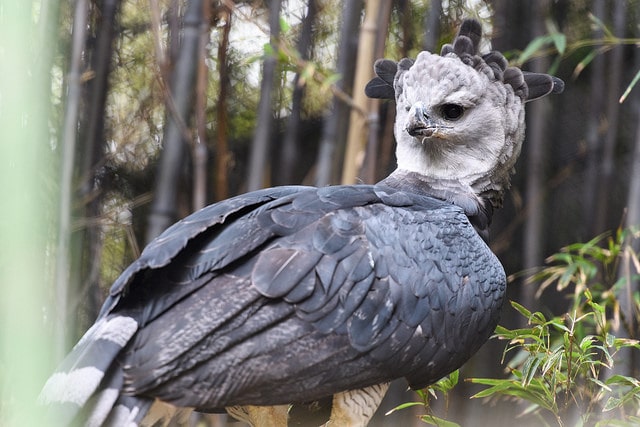
Source: flickr.com
With a proud feathered crest atop its head and 3-4 inch claws that rival a Grizzly Bear’s, the Harpy Eagle easily secures its place at the top of its local food chain. These fierce, winged hunters can take down prey such as sloths and monkeys with little effort. However, they also have a softer side: Harpy eagles are also known to work tirelessly alongside a mate to nurture their young. Male and female birds look alike in terms of plumage, with both sporting a double crest and similarly distinct markings. Females, however, can grow to be nearly twice as heavy as males.
Did You Know?
The beautiful Harpy Eagle stands proud as the national bird of Panama.
-
Steller’s Sea Eagle – (Haliaeetus pelagicus)
Wingspan: 6.4-8.2 feet
Location: Eurasian coastal areas
Identifying Trait: Very large, yellow beak
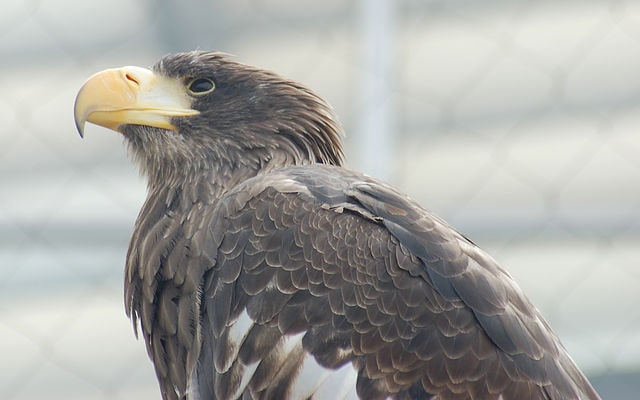
Source: wikimedia.org
Steller’s Sea Eagle weighs in as the heaviest eagle in the world on average. This large bird generally prowls coastal areas and frequents the Russian coast in search of food. Its diet consists very largely of salmon, but is supplemented with other varieties of fish as well as the occasional shellfish or crustacean. While the Steller’s Sea Eagle breeds almost exclusively on the eastern coasts of Russia, it has been witnessed migrating through China and (rarely) along North American coasts as well.
Did You Know?
The Steller’s Sea Eagle largely owes its astounding eyesight to the fact that it has forward-facing eyes. This sharp-sighted hunter can utilize either monocular or binocular vision depending on what its current situation calls for.
-
Lappet-faced vulture (Nubian Vulture) – (Torgos tracheliotos)
Wingspan: 8.5 feet
Location: Africa
Identifying Trait: Downy fuzz on their heads
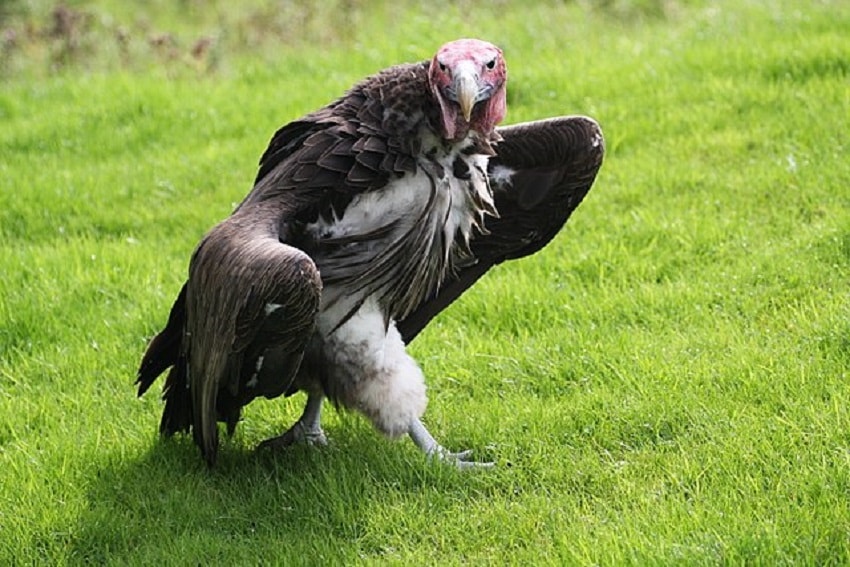
Source: wikimedia.org
Using its superb senses of sight and smell, the Lappet-faced vulture glides through the sky to locate the carrion that it feeds upon. Like some other gigantic vultures, this bird isn’t afraid to take down small to medium sized prey when carcasses aren’t readily available. This bird uses its formidable, hooked beak to tear through the hide to reach the meat it craves, and plays an important role in opening the carcasses for other birds that are too small to break through on their own. While most all other vultures have bald heads, the Lappet-faced Vulture has a unique coating of fine, downy hair on its head.
Did You Know?
The Lappet-Faced Vulture is generally a solitary bird, and does not nest in colonies like many other types of vultures do. This reclusive bird builds massive nests out of sticks in more secluded areas and has a wide territorial range.
-
California Condor – (Gymnogyps californianus)
Wingspan: 9.8 feet
Location: North America
Identifying Trait: Bright-skinned, bald head
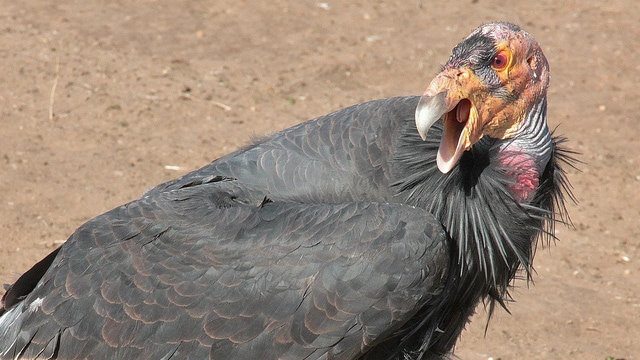
Source: flickr.com
Easily the largest flying bird in North America, the California Condor can soar on its massive wings at up to 55 mph by hitching onto wind currents mid-flight. This giant bird of prey can also roam the skies for an unusually long lifespan of 50 years or more in the wild. California condors prefer to nest in cliff caves, rock crevices, or redwood hollows. This bird tends to seek out ready nesting spots rather than building a nest, and does not generally refine its nest with sticks or other materials.
Did You Know?
The California Condor is a tough survivor, and is able to go 1-2 weeks without eating if necessary. Other self-preservation tactics include fluffing neck feathers for warmth in cold weather and urinating down one or both legs to cool off in hot weather.
-
Himalayan Griffon Vulture – (Gyps himalayensis)
Wingspan: 9.2 feet
Location: Himalayas
Identifying Trait: Downy coating of feathers on the head
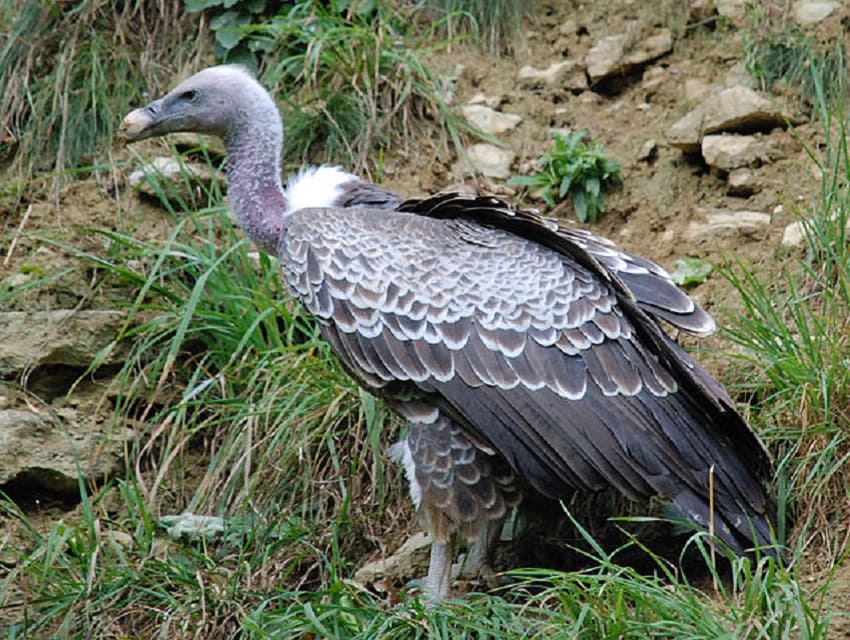
Source: wikimedia.org
Likely named for its nearly mythical proportions, the Himalayan Griffon Vulture has an impressive figure accented by its light hood of soft, downy feathers. Head feathers are uncommon among carrion birds, but serve as a distinct trait of the Himalayan Griffon. This characteristic hood of feathers is a light yellow or cream color in adult birds, and a brighter white in juveniles. The Himalayan Griffon Vulture commonly maintains loose colonies, and will travel in groups. These big birds also nest relatively near one another and lay single eggs.
Did You Know?
While the Himalayan Griffon Vulture generally keeps to itself and is unlikely to attack humans, it is technically a man-eater. These massive birds often play a key part in Tibetan Sky Burials by scavenging human remains placed upon the crags.
-
Eurasian Black Vulture (Cinereous Vulture) – (Aegypius monachus)
Wingspan: 8-10.2 feet
Location: Eurasia
Identifying Trait: Bald head and collar of feathers

Source: wikimedia.org
This colossal bird is a member of Accipitridae, the same family as kites, harriers, and buzzards. Many people have described the Eurasian Black Vulture as “halfway between a vulture and an eagle”, which makes sense when you take a look at its stern gaze and largely featherless head. This bird’s baldness is framed by a fluffy collar of feathers that fades in color with age, giving a visual indicator of how old each specimen might be. The silhouette of the Eurasian Black Vulture is distinctive as a result of the wide, blunt wings that keep this leviathan aloft.
Did You Know?
The Eurasian Black Vulture benefits from a specially adapted kind of hemoglobin in its blood that allows it to take in extra oxygen at higher altitudes.
-
Andean Condor – (Vultur gryphus)
Wingspan: 10.5 feet
Location: South America
Identifying Trait: Bald head and white collar
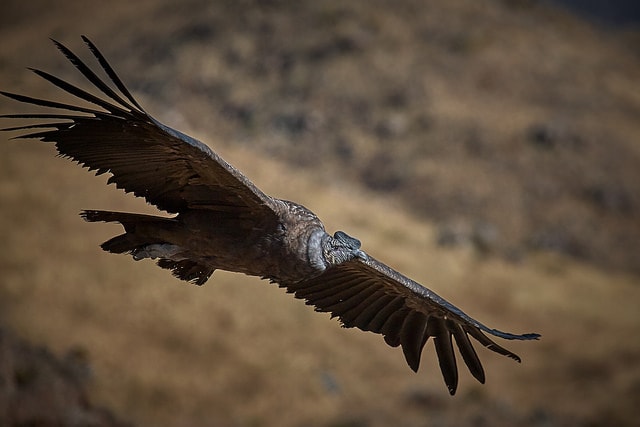
Source: flickr.com
The Andean Condor is the largest bird of prey in the world, and is also recognized as the largest of all birds that can fly. As a member of the vulture family, the Andean Condor sports the classic bald head that enables it to keep its face and neck clean while feasting upon carrion. Though this bird’s magnificent wingspan might make it appear to be a graceful flier, it actually has trouble staying aloft at times due to its hefty weight. As a result, the Andean Condor prefers to stick to flight paths that make use of mountain air currents to help support it midair.
Did You Know?
While this massive condor does not have talons as impressive as those of other birds of prey, it has been known to supplement its scavenged diet with eggs or hatchlings of other birds.
